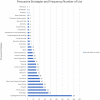Trends in Persuasive Technologies for Physical Activity and Sedentary Behavior: A Systematic Review
- PMID: 33733127
- PMCID: PMC7861265
- DOI: 10.3389/frai.2020.00007
Trends in Persuasive Technologies for Physical Activity and Sedentary Behavior: A Systematic Review
Abstract
Persuasive technology (PT) is increasingly being used in the health and wellness domain to motivate and assist users with different lifestyles and behavioral health issues to change their attitudes and/or behaviors. There is growing evidence that PT can be effective at promoting behaviors in many health and wellness domains, including promoting physical activity (PA), healthy eating, and reducing sedentary behavior (SB). SB has been shown to pose a risk to overall health. Thus, reducing SB and increasing PA have been the focus of much PT work. This paper aims to provide a systematic review of PTs for promoting PA and reducing SB. Specifically, we answer some fundamental questions regarding its design and effectiveness based on an empirical review of the literature on PTs for promoting PA and discouraging SB, from 2003 to 2019 (170 papers). There are three main objectives: (1) to evaluate the effectiveness of PT in promoting PA and reducing SB; (2) to summarize and highlight trends in the outcomes such as system design, research methods, persuasive strategies employed and their implementaions, behavioral theories, and employed technological platforms; (3) to reveal the pitfalls and gaps in the present literature that can be leveraged and used to inform future research on designing PT for PA and SB.
Keywords: behavior theory; health; persuasive strategies; persuasive technology; physical activity; sedentary behavior; targeted audience; targeted outcomes.
Copyright © 2020 Aldenaini, Alqahtani, Orji and Sampalli.
Figures















References
-
- Oinas-Kukkonen H., Harjumaa M. (2009). Persuasive systems design: key issues, process model, and system features. Commun. Assoc. Inform. Syst. 24:96 10.17705/1CAIS.02428 - DOI
-
- Fogg B. J. (1998). Persuasive Computers: Perspectives and Research Directions. Retrieved from: www.captology.org
Publication types
LinkOut - more resources
Full Text Sources

